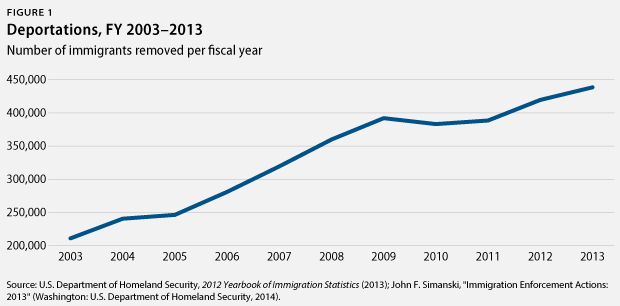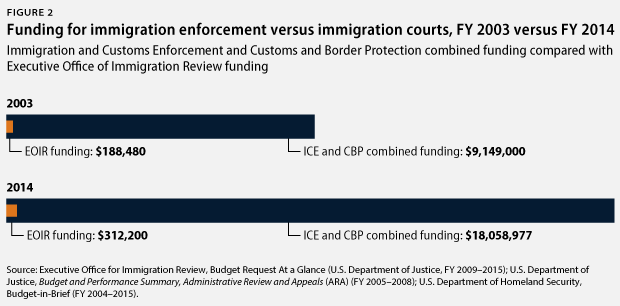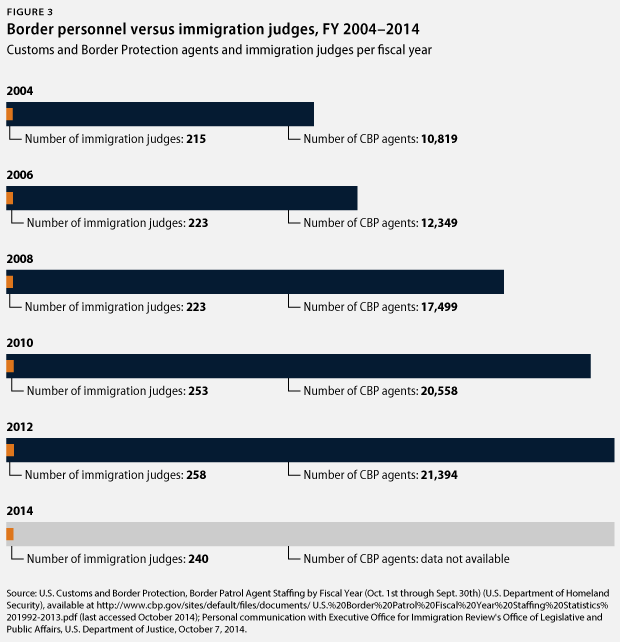Since the start of a concerted effort to deter unauthorized migration at the U.S.-Mexico border with Operation Hold the Line in 1993, the United States has invested massive resources in immigration and border enforcement. The country now spends more on immigration enforcement—nearly $18 billion per year—than on all other federal law enforcement combined. This enforcement overdrive has meant that the number of people deported each fiscal year has steadily risen (see Figure 1), as has the number of immigrants who are detained and prosecuted. As increased enforcement has put more immigrants into the removal process, the nation’s immigration court system has struggled to keep up. Over the past 15 years, the number of cases pending in the immigration court system has more than tripled, and today, it takes an average of 567 days for a case to be processed.

Mismatched resources
Funding levels demonstrate the stark divide between the rise of the immigration enforcement system and the relative stasis in immigration court capacity. Since the U.S. Department of Homeland Security began operations in 2003, the combined budget for Immigration and Customs Enforcement, or ICE, and Customs and Border Protection, or CBP—the primary agencies charged with enforcing immigration laws—has soared, doubling from more than $9 billion in 2003 to more than $18 billion in 2014. In contrast, overall funding for the Executive Office of Immigration Review, or EOIR—the immigration court system—is stuck in the millions, rising from only $188 million in 2003 to $312 million today. (see Figure 2)

The mismatch in resources comes into even starker relief when considering the number of personnel in the immigration enforcement agencies compared with the immigration courts. While the number of CBP agents has doubled over the past decade, there are only 23 more immigration judges today than there were in 2003, an increase of only 10.5 percent. (see Figure 3)

Unsurprisingly, with only 23 more judges than a decade ago and far more people moving through the immigration court system, both the number of cases currently stuck in the EOIR backlog and the amount of time it takes to complete a case have increased significantly. It now takes an average of 567 days for a case to make its way through the immigration courts. (see Figure 4) Recent attempts by the Obama administration to accelerate adjudications of unaccompanied children fleeing Central American violence will only increase these delays for others in the system.

These judges handle a crushing load of cases: The average immigration judge handles more than 1,500 cases per year, compared with only 420 cases annually for U.S. District Court judges. (see Figure 5)

This increased administrative burden has real-life consequences: Court hearings that drag on for years mean that some people—such as certain asylum seekers who are subject to mandatory detention while their cases are processing—remain stuck behind bars while their cases await adjudication. Even for those who are not detained, this limbo imposes significant emotional and economic stress on individuals and their families. These immigrants are generally not able to work legally—or, in the case of those who will ultimately win the right to stay permanently—to begin to build their lives in the United States.
A two-fold path forward
Addressing the issues that underlie the long backlogs in immigration courts will require providing the courts with adequate resources to handle the crush of cases currently before them. Increasing both funding and the number of judge teams available to hear cases is critical to ensure that people do not have to wait years for their immigration cases to be resolved. Likewise, providing immigrants with meaningful access to counsel—including, when appropriate, court-appointed counsel—will help speed up the proceedings and introduce more due process into the system.
But simply increasing resources will not solve the overarching problem of roughly 200,000 immigrants needing to appear before the courts each year in the first place. It is past time to reduce the volume of deportation actions. President Barack Obama’s expected executive action on immigration will hopefully begin that process by ensuring that low-priority immigrants who have been living in the country for years can get deferred action—a temporary reprieve from deportation. The executive action should also focus enforcement resources on tracking down and removing serious criminals, rather than on putting otherwise-law-abiding immigrants into the overburdened deportation system.
By resourcing the courts commensurate with their inflated caseloads and curtailing the number of people put into the system in the first place, the nation can work toward a more functional immigration court system.
Marshall Fitz is the Director of Immigration Policy at the Center for American Progress. Philip E. Wolgin is Senior Policy Analyst for Immigration at the Center.
The authors would like to thank Angela Maria Kelley, Sharita Gruberg, Michael Fubini, and Jonathan Valdez for their assistance.